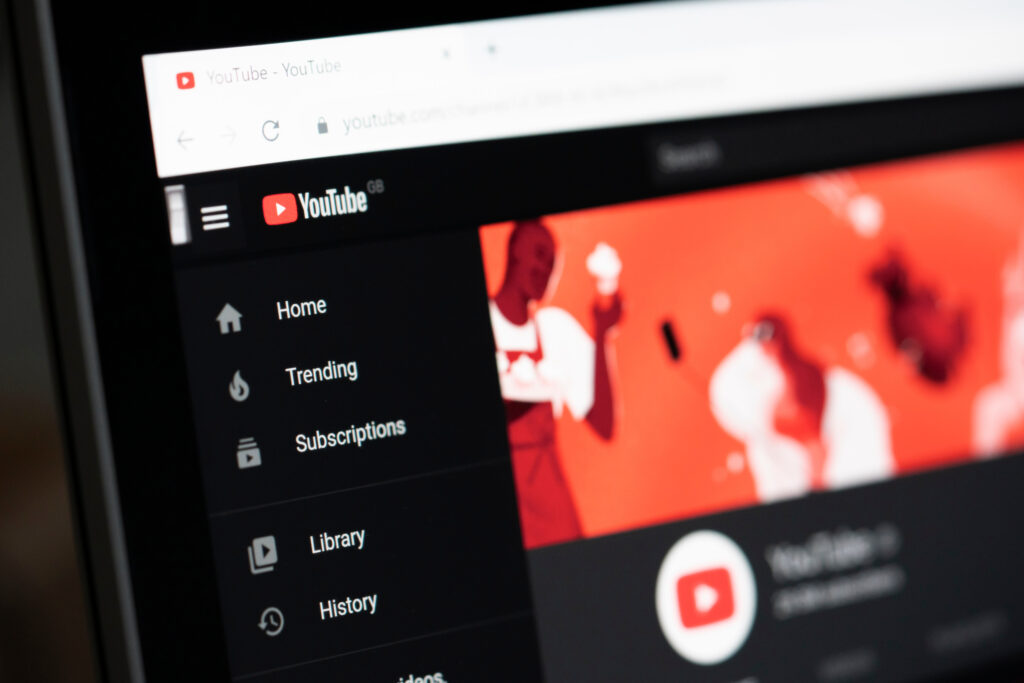Before you invest time learning how to optimize YouTube videos for maximum reach, there’s a prerequisite to consider: Just how valuable is YouTube as a marketing channel, anyway?
Like all marketing channels, the baseline answer is, “It depends on how you use it.” But considering the sheer size and commitment of the YouTube audience, the potential is obvious:
In 2023, 2.6 billion users went on YouTube every month, churning through 694,000 hours of video every minute.
Only one website beats YouTube in global traffic, and that’s Google—a tough one to top, since Google tends to be the easy button for finding whatever it is you’re looking for on the internet, including video content.
The gargantuan girth of YouTube’s daily audience probably isn’t a surprise to many marketers. But it can still be tough to process the full scope of content competition.
Users are picking through at least 800 million individual videos on YouTube when they hit the homepage or app—it’s hard to pinpoint exactly how many videos there are in total, because almost 4 million new videos are uploaded to YouTube every day.
So, if we’re marketing a brand and aiming to use YouTube as a tool, how do we stand out in an ever-expanding cosmos of content? How do we even reach the eyes of users who’d benefit from what we make or do? Is YouTube content really worth investing in?
Most digital marketing specialists would say yes, so long as you commit to creating compelling content that plays precisely to the platform’s strengths and optimizing it to communicate effectively with YouTube’s algorithm.
Do that right, and you’re engaging eager consumers who are looking for your solution to their problems. Do it wrong, and you’re tossing a message in a bottle into a choppy, never-ending sea.
There’s no easy button for getting YouTube content right. But there are tried-and-true tactics that can help you maximize YouTube reach—and aim right at your ideal audience—so you’re wringing the highest possible ROI out of your YouTube marketing investment.
Why YouTube Marketing
is Worth the Investment
To set more specific expectations about YouTube as a marketing tool: Most people think of it as a music streaming/creator shenanigans hub, and that’s not unfounded. About 82% of YouTube users turn to the platform as a source of entertainment, according to Semrush, and the most-streamed YouTube content largely consists of music videos, from “Baby Shark” to Ed Sheeran.
That said, 18% of YouTube’s users say they’re specifically using the platform to follow brands and companies. That’s nearly 470 million engaged users, actively streaming content by and about brands they like, each and every month.
As marketers, those people are our people, and investing in YouTube content—while focusing on reach-maximizing tactics—is how we help them find us and our products or services.
Here’s what you can get out of successful, focused YouTube marketing efforts:
Brand awareness.
YouTube is a playground for engaging and informative videos, and when customers find you through relatable content rather than directly through ads, there’s a genuine connection. The vast majority of marketers find clear ROI here—in Wyzowl’s 2023 survey, 95% of marketers said video helped them increase brand awareness.
Lead generation.
Those hundreds of millions of monthly YouTube viewers aren’t just passive observers; they’re ready to be convinced to convert. A captivating video with a clear call to action can turn viewers into website visitors, email subscribers, or paying customers. A fun, famous example: Dollar Shave Club, which turned a surplus of twin razors into a billion-dollar success story with a viral launch video (and smart follow-up content).
Sales success.
Increased reach and engagement tends to translate to sales. Going back to Wyzowl: 87% of marketers said video helped them increase sales.
Conquering Keywords:
Researching for YouTube Success
Step one in maximizing reach on YouTube: figuring out what kind of content to create.
Content marketing of all kinds—including YouTube marketing—relies on creating compelling content that your ideal users want. Other reach-expanding tactics can only do so much if you’re not producing videos with a savvy, audience-centric strategy behind them.
The key to developing a successful content strategy focused specifically on your audience: deep research.
With YouTube marketing, keyword research is the foundation of video pre-production. It comes before you’ve filmed or edited a single frame, and it’s a step you absolutely shouldn’t skip, even if you whole-heartedly believe you know exactly what your ideal audience wants from you.
If you think of YouTube as a massive labyrinth of content, keywords are secret doors that open up to your goals. Find the right door, and you unlock an audience that’s actively searching for exactly what you make or do. Pick the wrong door, and you’re back in the labyrinth.
Mastering YouTube keyword research isn’t easy, but it’s doable. Here’s a step-by-step to get started:
- Define your niche.
Marketing 101: Know your audience. Who are you trying to reach? Gamers? Gardening enthusiasts? Construction pros? People looking for behavioral health solutions? The more specific, the better.
With your audience in mind, start a content brainstorming session. Write down relevant topics, questions, and phrases related to your niche. Think about what your ideal viewers might be searching for.
- Turn to YouTube-specific tools and tactics.
With your brainstorming results in hand, you can tap free and easy YouTube search predictions to get a general indication of relevant keywords. Start typing from your list and see what the platform itself recommends. It’s quick, intuitive, and a goldmine of trending topics.
Another free and easy tactic: Pore through your competition’s content. Check out successful channels in your niche and see what keywords they’re using. You’re not looking to steal their content strategy, but if they have a strong foothold, there’s a lot you can learn from studying their approach. What kinds of keywords are delivering their best results?
When you’re ready to level up your research, paid platforms including Ahrefs, VidIQ, and TubeBuddy offer advanced YouTube keyword research features. They reveal search volume, competition analysis, and related keyword suggestions, all of which make your YouTube keyword research faster and more precise.
- Analyze what you find.
Once you’ve done a deep dive, start sifting through your research for keepers and throwaways. Two words to keep in mind as you’re culling keywords: balance and blend.
Strike a balance by choosing keywords that have decent search volume (i.e. people are actually looking for them) but manageable competition (if there’s already a ton of content based around those keywords, especially by major YouTubers, you’re right back in the labyrinth).
Mix it up by using a blend of short, specific keywords and longer, more conversational phrases. Think “retirement planning tips” and “how to build passive income streams and retire early.” Cater to all search styles.
- Create a keyword master list.
Build out a single source of truth for your YouTube content research. We like keeping it simple and using a spreadsheet, so you can easily outline and keep track of all your promising keywords and their stats and share with a team. As you create content calendars, this YouTube keyword master list is your guide.
Crafting Content That Reels Users In
Forgive the fishing analogy to follow—but in this YouTube-content context, it’s apt.
Keyword research gives you your bait: something you’re certain the customers you’re fishing for want or need. Having the right bait is key, but effectively casting that bait is just as important, and it takes focus, time, and skill.
Properly crafting (then effectively deploying) your video is how you use your bait to entice, hook, reel in, and capture your prized user, who’s been swimming through that vast sea of YouTube content.
Here’s a step-by-step on shaping keywords into captivating content:
- Hook your audience.
The first 15 seconds are key to user retention, so as you’re scripting and/or storyboarding your videos, focus on delivering a big hook right up front. Ask a question your audience needs to know the answer to. Offer an inviting anecdote you know they’ll relate to. Deliver something visually stunning that they can’t look away from.
Then offer a picture of possibility. You know what your audience wants and needs, because you’ve done the research. Your content is based around those specific wants or needs. Give them a glimpse of their goals achieved—precisely what they were looking for, in practice.
Invite them to keep watching and learn the way forward.
- Hold your audience.
Powerful content embraces the classic tenets of storytelling. Don’t just sell to viewers; weave your concept into a narrative with a setup, climax, and resolution. Take them on a journey. Use real-life examples, expert insights, and even humor (if it aligns with your brand voice).
As you develop the story, make sure you keep it moving visually too. Break up talking heads with B-roll, static shots, or animated text that complement your narrative.
- Reel your audience in.
Don’t leave viewers dangling. As your video wraps up, tell viewers what to do next if they want to take advantage of the solutions your brand delivers.
Encourage them to subscribe to your channel for more expertise, download a free resource, or visit your website to shop and save. Make the CTA clear, actionable, and easy.
But remember, too, that a CTA isn’t all it takes to make a connection and conversion. Content marketing is about setting up a conversation, not a monologue. Respond to comments, answer questions, and engage with your audience. Support the CTA and show users that you’re committed to solving their problems, not just making a sale.
Mastering Metadata to Support Search
Keyword research helps you create YouTube content your audience wants. Metadata—title, thumbnail, description, tags—is how you tell your audience and the YouTube algorithm, in no uncertain terms, that your content delivers on a specific desire.
Here’s how to make metadata work:
- Fine-tune first impressions: title and thumbnail.
Your video’s title and thumbnail are what searching users see first (and your title is a key indicator to the YouTube algorithm), so you want to make a clear, compelling, and memorable first impression. Craft a title that’s attention-grabbing, relevant to your keywords, and concise (60 characters is a good rule of thumb).
YouTube thumbnail best practices could be their own article, but starter tips to keep in mind:
- Do create a custom thumbnail.
- Design with a 16:9 aspect ratio.
- Use an eye-grabbing image that accurately reflects your content.
- Include a quick, catchy headline that supports the title (and accurately reflects your content).
- Tastefully integrate your logo.
- Keep the design aligned with your branding.
YouTube’s own data indicates that it’s worth taking the time to craft a good thumbnail—90% of their best performers have a customized thumbnail.
Check out some of the bigger brand accounts on YouTube, like Lego and Nintendo, and you’ll notice something their best-performing content has in common: well-designed, consistently branded thumbnails and titles that harmonize.
- Dive deeper in your description.
This is your chance to elaborate on your title and encourage users to press play (while dropping in keywords that clarify intent to the algorithm). Use your chosen keywords naturally, remember a call to action, and consider adding timestamps for specific topics within the video if that’ll benefit the user (and make for natural keyword inclusion).
- Tag it strategically.
Tags can expand your discoverability and clarify the focus of your content. Use a mix of general and specific tags related to your video content and niche. Aim for between five and 15 tags across that spectrum.
Not sure which to include? Checking successful related content to see what tags they use is a good start. You can also use YouTube’s autocomplete feature or paid tools like TubeBuddy to see what tags are commonly used for videos in your niche.
- Cross-promote with info cards.
YouTube cards allow you to link viewers to other videos, playlists, or even your website. Have another video that goes deeper on this topic or attacks it from another angle? Promote it within a card. Have content on your website that’d support your customer’s learning process? Link there (if you’re eligible for the YouTube Partner Program).
YouTube has an easy how-to on adding info cards to your videos. Just make sure you’re letting your customer journey, not your marketing wants, guide your card inclusion.
Promoting YouTube Videos
Beyond the Platform
Optimizing your content within the YouTube platform is a great start. But it shouldn’t be the beginning and end of your efforts to optimize reach.
Pulling in as many eyeballs as possible means promoting beyond the platform, via social media, paid advertising, and more.
Promotion approaches to think about:
- Integrate into your social content calendar.
Share your video on your brand’s Facebook page and in relevant groups. For the best results back on YouTube, think irresistible teaser clips with a link to the full video.
On X (formerly Twitter) or Threads, share snippets of (and a link to) your video and post engaging questions related to your content to spark conversations and attract viewers. Think: “Ever seen a Caterpillar excavator undercarriage system this far gone? Watch to see how we brought it back to life.”
On Instagram, post wow-worthy stills or behind-the-scenes captures from your video, and utilize Stories for direct YouTube linking opportunities.
- Connect and collaborate.
Are there creators in your niche who’d make excellent cross-promotion partners? Simple co-shares can grow into cool collaborations like joint videos and guest appearances that expand reach on both sides.
Your content can bring value to relevant blogs and websites, too. Reach out and offer your videos as valuable resources to embed and/or share.
- Build an advertising budget.
Promoting via YouTube ads taps the audience already on the platform. You can target your ideal users with pre-roll, mid-roll, or display ads.
Boosted social media posts can extend your reach beyond your followers, too, without the need for a massive advertising budget.
Always, Always Analyze and Adapt
Important to remember: Using YouTube as a marketing platform is a journey, not a destination. You’ll get better results next time by tracking every video’s performance and tweaking your tactics based on user data.
Use YouTube Analytics to see where your views are coming from, what demographics are engaging with your content, and what’s working (and what’s not). Then adapt accordingly with an eye on maximizing reach and engagement.
That might mean leaning more into how-to videos and less into product explainer videos. It might mean switching up social media platforms or trying different ad targeting options.
Be patient, experiment, analyze, and repeat. By consistently creating audience-centric content and actively promoting it, you’ll grow on YouTube—even if it’s slow and steady, it’s a win.
Snapshot: Your YouTube Production and Promotion Partner
If you’re struggling to balance planning, producing, and promoting YouTube content, you don’t have to go it alone.
The Snapshot team specializes in video production and digital advertising, so we’re here to manage as much or as little as you need, from developing and implementing a full YouTube content strategy to managing social media ads promoting content you already have.
Tell us about your marketing goals, your video aspirations, and what kind of support your team needs—YouTube marketing expertise is just an email away.








